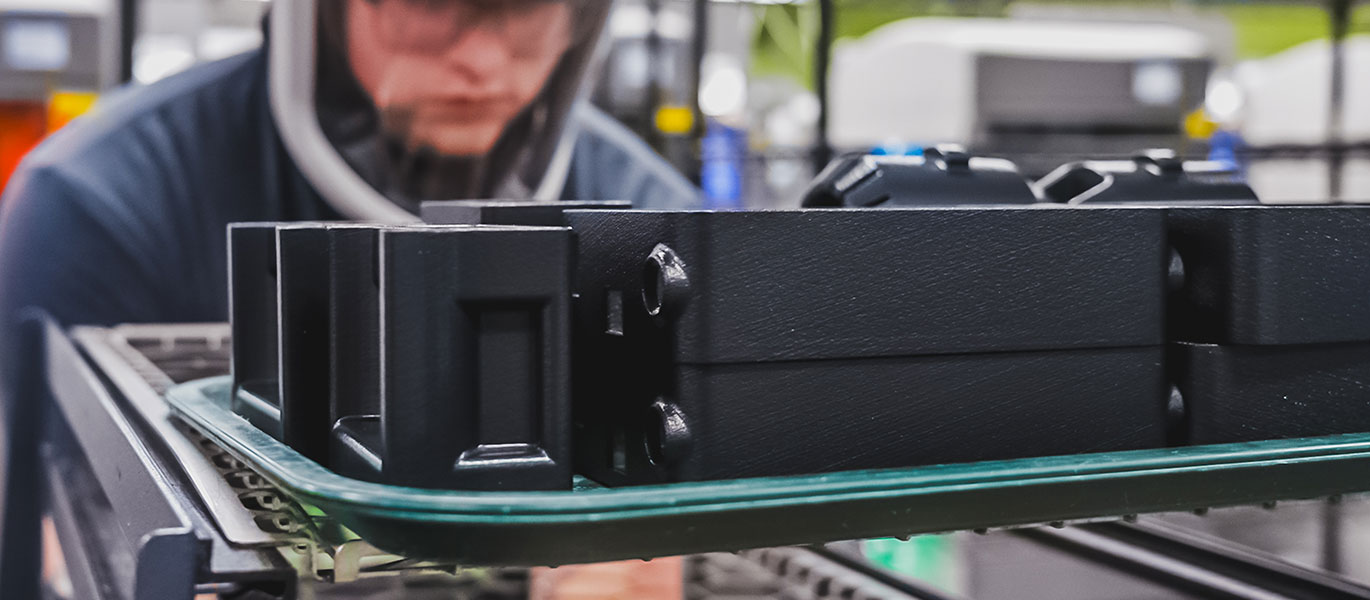Interested in learning how 3D printing with Protolabs could benefit your part? Upload your part today and explore options via our digital quoting platform, or reach out to one of our applications engineers at [email protected] or 877-479-3680.
We get it. Everyone likes to control their own destiny, and for the manufacturing world, this means making parts in-house. Fortunately, low-cost desktop 3D printers have made prototyping and low-volume production affordable for even hobbyist-level budgets. They're also convenient, easy to use and, as their name suggests, small enough to fit on a desktop.
But does that make DIY printing the right choice? Maybe, but then again, maybe not. Deciding whether to outsource some or even all of your 3D printing depends on a host of factors, including the desired part quality and quantity, how quickly you need it, accuracy requirements, material selection, and much more. Let's evaluate some of the reasons for each approach, beginning with materials.

Finishing options like vapor smoothing provide cosmetic benefits not possible at home.
Cost Considerations
Design firms and product developers have long subcontracted their metal part manufacturing needs to qualified machine shops, which make significant investments in CNC equipment that requires skilled machinists to operate. It’s the same with metal 3D printers. Depending on the build volume and 3D printing technology, companies can expect to spend at least as much for a metal printer as they would for a CNC machine tool, and probably much more. With that comes extensive training and process development, never mind the post-processing these parts require. For all but large service providers and some OEMs, metal additive manufacturing (AM) is usually a non-starter.
Polymer printing fares better in this respect. A number of sub-$10,000 desktop FDM (filament) or SLA (resin) printers are available, and as noted earlier, these machines are fairly easy to run. They also offer a wide selection of materials that cover the lion's share of printing needs. One of the main exceptions to this is nylon, an engineering-grade polymer only available on more expensive (often much more) SLS printers. Regardless, these feedstocks (especially resins) have limited shelf lives and should be stored according to the manufacturer's recommendations, which usually means keeping them in a vacuum-sealed container in a cool, dark place.
Desktop vs Industrial 3D Printing
That said, desktop printers are not in the same class as the industrial-grade equipment used at manufacturers like Protolabs. They are slower, less accurate, and boast smaller build volumes than true production machines. They're also less robust and require routine maintenance that many users fail to anticipate. And despite their office-friendly moniker, desktop printers should be used in an enclosed area with good ventilation to remove fumes and harmful VOCs (volatile organic compounds). Yes, these entry-level machines are an attractive option for many companies, but there are reasons for their lower cost.
Leverage External Expertise
Just as some people like to tinker with cars or make home improvements, many in the design and product development community prefer to print their own parts. That's cool. But sometimes projects require the knowledge gained by years of experience and thousands of print jobs. As many have discovered, operating a desktop 3D printer is not terribly complicated. Nor is it rocket science to prepare a CAD file for printing, which requires the user to import the model, slice it into layers, and generate supports to keep the part from drooping or curling during the build. What's less clear is where to place those supports, how to position the workpiece within the build chamber, how the dozens of different materials behave, and how to design parts for effective 3D printing. Climbing this learning curve can be a lengthy, expensive process.

A wide selection of materials, extremely high feature resolutions, and quality surface finishes are all possible with stereolithography (SLA).
More Tech Options and Increased Capacity
Your part might also require a specific type of printer. The term 3D printing refers to a family of technologies that includes SLA, FDM, SLS, DMLS, MJF, DLS (including Carbon), PolyJet, and a few others, each with unique capabilities and rules of the road. Then there's large format printing (for big parts) and microfine printing (for tiny details and extreme resolution), neither of which is possible on a desktop machine. Add to this the coordinate measuring machines (CMMs) and other metrology equipment needed to inspect parts, vapor polishers to smooth them, never mind the bead blasters, drill presses and milling machines, painting equipment, and dye tanks. It's all this other stuff that turns good 3D-printed parts into great 3D-printed parts. Unless your company has deep pockets and much more available space than a desktop in the middle of the office, outsourcing is most likely the way to go.
Lastly, there are capacity considerations. Once you've printed that first part on your desktop machine, what's the next step? Others in your company will want access to the printer, so unless you want to come in after hours, it's not fair to hog its available capacity. And a big piece of any successful product development project is delivering higher volumes of parts with process like molding and machining. Partnering early on with a provider that can not only help guide your part design and make it more manufacturable but can then take the baton and run with it—these are advantages that only outsourcing provides. Maybe it's time to clear your desk.
Outsourced vs. In-house 3D Printing: Side-By-Side Comparison
|
|
Advantages |
Disadvantages |
|
Outsourced |
|
|
|
In-house |
|
|

If you have any issues getting your guide, click here to download.









